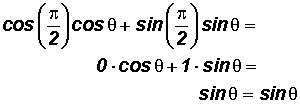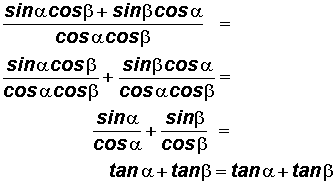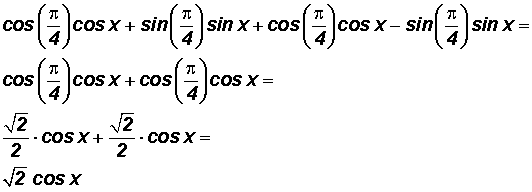SUM AND DIFFERENCE IDENTITIES
DOUBLE ANGLE AND HALF ANGLE IDENTITIES
Example 1:
Show that
can be changed to sin
.
Let's use the Difference Identity for Cosine
.
Here, u
and v
.
Your calculator must be in radian mode!
We showed that
equals sin
.
Example 2:
Show that
can be changed to
.
Let's use the Sum Identity for Sine
.
Here, u
and v
.
We showed that
equals
.
Example 3:
Simplify
using the Sum and Difference Identities of Cosine
and
.
Evaluate trigonometric ratios as necessary.
Here, u
and v
x.
We showed that
can be simplified to
.
Example 4:
Simplify
using the Double Angle Identity
.
Let's factor out a 3 to get
.
We showed that
can be written as 3 sin2x.
Example 5:
Simplify
using the Double Angle Identity
.
Let's factor out a 4 to get
We showed that
can be written as 4 cos2x.
Example 6:
Simplify
using the Double Angle Identity
.
Here, u
x.
Let's multiply the parentheses using FOIL to get
We showed that
can be written as cos 2x.
Example 7:
Simplify
using the Half Angle Identity
.
We can see that u
6x, therefore
3x.
Using the pattern of the Half Angle Identity, we can write
as sin 3x.
Example 8:
Simplify
using the Half Angle Identity
.
We can see that u
4x, therefore
2x .
Using the pattern of the Half Angle Identity, we can write
as cos 2x.
Example 9:
Rewrite
in terms of a Double Angle Identity and a Half Angle Identity:
Using
:
We can see that 2u
6x, therefore u
3x.
Using the pattern of the Double Angle Identity, we can write
as 2 sin 3x cos 3x.
Using
:
We can see that

6x, therefore u
12x.
Using the pattern of the Half Angle Identity, we can write
as
.



